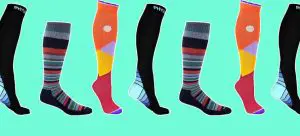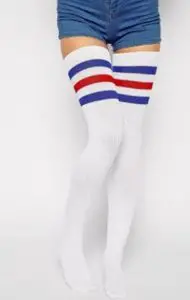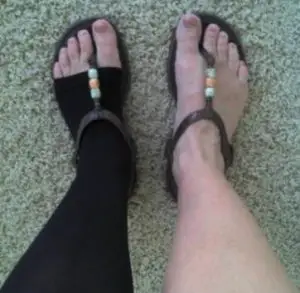Compression stockings or socks can be found anywhere, and you might have seen them before, unbeknownst to you. They are specially designed stockings with a stretchy property that makes them gently squeeze around any length of legs. Compression stocks are primarily made to help improve poor blood circulation.
Health care specialists often recommend compression stockings to patients after a certain surgery. The reason is to allow the free flow of blood in a patient’s leg and protect their legs from developing blood clots (DVT). Hence, the essence of compression stockings after surgery is to protect patients from the ‘mobility issues’ they may experience after surgery.
As you continue to read this, you will find the best answers to some essential ‘how, why, and when’ questions on compression socks. Let’s dive into the first question, “why do people wear compression socks?”

How Long To Wear Compression Socks?
Does wearing compression socks for a long period cause any harmful effect on the body? Is there an appropriate extent to which compression can be worn for the user’s safety? There is, however, no limitation to how long you can wear your compression socks. You can wear them all day long, and you can also wear the socks daily without any health complications. Meanwhile, it is advisable to take them off before you go to bed.
The primary purpose of wearing compression socks is to allow or improve the circulation of blood. If they do the opposite, you should discard them. Compression socks usually cause poor circulation of blood when you don’t take them off before falling asleep. Chances are, the stockings will become bunched up and rough, and it will impede your blood circulation.
Meanwhile, you will notice it if your compression socks get bunched up during the day, and make them smooth on your legs again by pulling them up. So it is always advisable to take off your compression socks before sleeping to avoid discomforts that may lead to serious health issues.
Furthermore, you can wear your compression socks while in several positions without worrying about “poor blood circulation.” Meanwhile, you should always be awake whenever you wear them in laying down or reclining positions.
The reason is to pull up the socks whenever they get bunched up for better circulation. You should, however, contact your health care specialist if you have any infection on your legs and feet.
How Often To Wear Compression Socks?
You can wear your compression socks as many times as needed. Meanwhile, your purpose for wearing them determines how often you wear them. If you work in a place where you have to stand for long, you will often wear your compression socks to work to relieve the tiredness on your legs.
If you use the socks for medical reasons, how frequently you wear them will depend on your doctor’s recommendations. You may be advised to wear your compression socks more or for a particular number of days in a week. Meanwhile, if you have underlying health problems like diabetes and arterial insufficiency, you should not use compression socks to avoid health complications.
When To Wear Compression Socks?
The various purposes of using compression socks determine the appropriate time to wear them. Compression stockings can be used for medical purposes, sporting activities, and tiredness. When it comes to the use of compression socks for medical reasons, it is advisable to wear them only during the day. You should take them off at night before going to bed and then put them on again the next morning.
If your work often requires you to be on your feet for an extended period, you should always wear your compression socks before going to work. You should, however, take them off after work, for the socks have served their purpose.
Lastly, you can also wear compression socks before any sporting activity. Research has shown that compression socks positively impact an athlete’s performance during a sporting event. Therefore, compression stockings are not only suitable for people with poor blood circulation but also for athletes and workers.
When Not To Wear Compression Socks?
Generally, compression stockings or compression socks offer essential health benefits, but a few people can not enjoy these benefits. Hence, it is always advisable to seek the expertise of a health care specialist before you self-prescribe compression socks. There are a few diseases that alter the health benefits of these stockings. If you have any of these diseases, compression socks are a ‘no go area’ for you; else, you will experience serious health problems.
People with peripheral vascular disease on their lower extremities should not consider the use of compression socks. This is primarily because the socks may worsen your current ischemic disease. Diabetic patients are also advised to stay away from compression stockings. Diabetic patients can not feel changes in their feet due to neuropathy, so they should stay off the stockings to avoid further complications.
People with arterial disease (arterial insufficiency) may also experience fatal side effects of using compression socks. It may result in necrosis of the skin and muscle, which is harmful to the body. Lastly, it is essential to visit your doctor before self-prescribing compression stockings to maintain your health. It will also protect you from further complications if you have any underlying disease.
Why Wear Compression Socks?
The ‘why do people wear compression socks’ question is synonymous with ‘what are the benefits of wearing compression socks.’ Compression socks are different from the regular socks people wear before wearing their shoes. The tightness of compression socks on the feet and legs is greater than that experienced with the regular socks.
The tightness you will experience on your feet and legs when you wear compression socks is the source of the socks’ health benefits. The tightness caused by compression socks leads to improvement in circulation and reduction of swelling. Hence, relieving the general feet and leg discomfort is the primary benefit of compression socks, in simple words.
The tightness leads to consistent pressure, and this pressure stimulates the circulation of blood from the ankles to the heart. The veins in the ankle serve as a passage for the flow of blood from the legs to the heart freely. Many people wear compression socks to serve as a cure or solution for aching or fatigued legs — especially people whose jobs require them to be on their feet for a long period.
Some people use compression stockings for medical purposes, such as blood clots in the vein, which is known as Deep Vein Thrombosis (DVT). Deep Vein Thrombosis is a dangerous health issue that may lead to the blockage of blood circulation to the lungs resulting in pulmonary embolism, a fatal health problem.
How to Wear Compression Socks in Style?
– With shorts

The best style of compression socks with shorts depends on your taste, lifestyle, and health conditions. Meanwhile, irrespective of these factors, pantyhose, and thigh-high stockings are the best to wear with shorts.
– With leggings

You can wear your compression socks under your leggings to make them fit your leg perfectly.
– Wear winter warm compression socks

Winter warm compression socks are designed to cover the feet to Increase warmth. They are an excellent option for cold days because they provide a substantial amount of warmth to the wearer. They are suitable for closed-toe shoes.
– Wear open toe compression socks

Open toe compression socks are made to end at the base of your toes. The exposure of your toes in these compression socks promotes breathability. They are suitable for wearing with sandals, peep-toe shoes, and flip-flops.
How To Wear Compression Socks Correctly?
It is essential that you follow the right procedure for wearing compression socks to avoid folds and bunching. If you wear them the wrong way, the socks will have folds and bunching, hence, exposing you to poor blood circulation. To avoid such events from happening, follow these tips yo wearing compression socks correctly:
1. Insert your hand into the socks
Slide your hand into the stocking until your thumb reaches the heel. Meanwhile, ensure your heels are raised.
2. Turn the socks inside out
Pinch the heel of the compression stocking with your thumb and fingers, and flip it inside out by sliding the stocking over your hand.
3. Begin to put the socks on
Hold the stocking and slide your foot into the hole you created, starting from your toes.
4. Get the heels situated properly
Make sure the heel of your stocking is exactly beneath the heel of your foot by sliding the stocking up.
5. Pull the rest of the socks up
Holding the end of the socks, which is usually an elastic band, pull the socks up towards your knees. It is best if you stop two inches below your knees and then smoothen out the surface of the stocking around your leg. You should ensure you massage out the wrinkles on the stocking for even distribution of pressure and good circulation.
If you want to enjoy the full benefits of your investment, it is essential that you follow the steps listed above on how to properly wear compression socks. Following these steps will also help you maintain the quality of your compression socks, hence, making them last for an extended period.
Why Can’t You Wear Compression Socks To Bed?
Compression socks help promote circulation and the relieving of leg fatigue. Meanwhile, the socks only work with gravity, so you function perfectly when you use them during the day when you’re most active. They do nothing but expose your health to risks and complications if you sleep with them at night.
You will be exposed to the following complications:
●Paresthesia
●Increased Risk of Deep Vein Thrombosis or Pulmonary Embolism
●Block the flow of blood
●Complicate underlying varicose vein
Paresthesia
Paresthesia is commonly called numbness or tingling of the skin. You will experience paresthesia alongside other skin irritations if you don’t take off your compression socks before sleeping.
Increased Risk of Deep Vein Thrombosis or Pulmonary Embolism
Wearing compression socks to bed will expose you to DVT, which stands for Deep Vein Thrombosis. It is a health problem that involves the formation of blood clots in the veins. These blood clots can travel to your lungs via the veins and lead to a fatal condition called pulmonary embolism.

The symptoms of this health complication are pain, warmth in your leg, especially the calf area, and swelling. You should visit a doctor once you notice these symptoms before the condition worsen.
Block the flow of blood
Compression socks usually apply pressure on the veins of your leg, and this will hinder the free flow of blood. Hence, it is not advisable to wear compression socks for twelve hours at a stretch. Meanwhile, you can use them when you are active because compression socks function with gravity.
Gravity opposes the effect of pressure when you are working, but it doesn’t when you sleep. It is, however, essential to your health that you take off your compression socks before sleeping.
Complicate underlying varicose vein
Varicose veins are primarily caused by poor blood circulation, hormonal changes (pregnancy or birth control pills), blood clotting disorder, and aging. These veins are large, and their enlarged size is due to the pressure they have been subjected to one way or the other. If you have a varicose vein, you avoid wearing compression socks to avoid further complications.
FAQs:
How long to wear for various conditions?
– After surgery
You can wear compression socks during the day and every day after surgery. But, you should always take them off before going to bed.
– After knee replacement
You should wear them for about 10 to 30 days, depending on how fast the swelling reduces. The surgeon will determine the perfect time to cut or roll down the compression socks.
– After lipo
Generally, you can wear compression socks after lipo for about 1 to 3 weeks. The surgical procedure will, however, determine how long you should wear the socks after lipo surgery.
– During pregnancy
You can wear compression socks any time, except at night, as long as you are comfortable.
– Fora plantar fasciitis
Six-hour per night until you are no longer in pain.
– After back or shoulder surgery
As much as possible until you’re able to move around comfortably.
– After tummy tuck
Six to eight weeks after surgery.
– After running
At least six hours to prevent pain and swelling.
– After c section
At least seven days. But it may be longer if you’re at high risk for thrombosis.
Conclusion
Compression socks are made to allow the circulation of blood and relieve aching legs from their pain. Although they are medically benefitting, you are allowed to wear them when you go to sleep, irrespective of your reason for wearing these socks.





